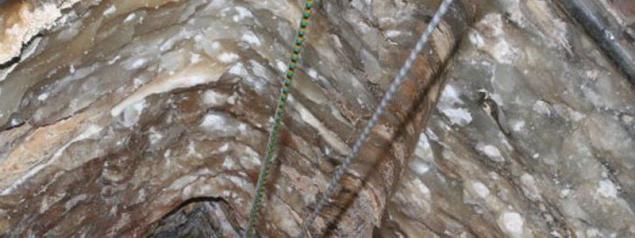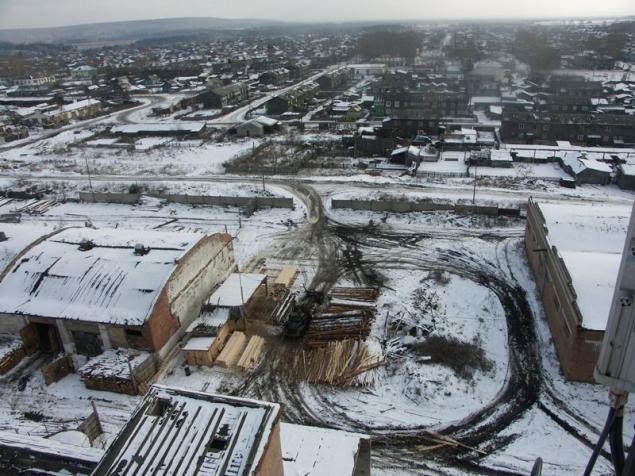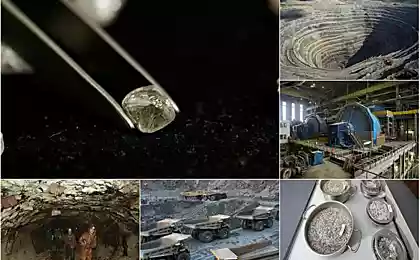723
The cellular network in Yakutia (9 photos)
What happens with the base stations at -60 Celsius?

The base station is delivered by winter road
Winter road - it is such a road that is passable only a few months a year. Her every time you need to build anew, because it is, in fact, made of pressed snow and ice. As the temperature drops to -15, a winter it will be possible to move through the creeks, ditches and bogs, and various small lakes. In Yakutia, about 7000 kilometers of winter roads laid from mid-December to April. This is 60% of the length of roads in the region.
When it becomes more "poprohladnee" (happens to -60), buses can not stand. It also creates a special entourage during installation. Half of the base stations in Yakutia reaches the places it on the winter road, so we have a very interesting plan - six months when we are ready to expand, and then try to deliver all the equipment until the roads are passable. In summer, service is only possible by helicopter.

The base station for the village of Nama tells us that the 2012 season is closed - the car fell into the lake. Equipment awaited in December 2013 for delivery to the place.
Installation in the permafrost
About shipping in general you already represent. Meet Now, it - the permafrost. It is almost all over the country.

In the permafrost can not be so simply go and dig a hole under the pile. Imagine that the installation goes on something, it is very reminiscent of the stone. Only the strange stone.

Before laying the foundation
To link objects worked in permafrost conditions, require the use of specific technology. In summer, temperatures in Yakutia can reach high values, which can lead to thawing of the soil under the foundations of base stations and a threat to their functioning.
To avoid this, it was applied sezonnodeystvuyuschie cooling unit (MCS), which is a sealed structure charged with refrigerant. They cooled the foundation and prevent the permafrost to thaw. These devices are installed in the foundations of the 19 most complex objects of communication "Beeline" in the country providing them with year-round reliable operation.

The foundation with the JMA
Construction of the network in the Far East
Building networks in Yakutia - is one of the largest conducted by "Beeline" in the Far East.
Overall, throughout Eastern Siberia and the Far East in 2013, the company has built more than 1,000 base stations of GSM and 3G. This building was the largest in the history of "Beeline" in this region of the country.
The greatest amount of work carried out for the development of GSM-network in accordance with the licenses for the provision of services to the Company in 2011 to 7 in the Far Eastern region: in the Primorsky Krai, the Republic of Sakha (Yakutia), the Jewish Autonomous Region, the Magadan Region, Chukotka Autonomous District, Koryak Autonomous District and the Kamchatka Krai Ust-Orda Buryat Autonomous District, Irkutsk Oblast.
By the end of 2013, the region built more than 1250 base stations. In total the project involves the launch of about 1750 base stations by 2018, that is, we still have a lot to do. As a result, the connection appears in all towns with a population of more than 200 people. In the vast majority of small towns cellular never had.

In the village of Krasny Yar (Primorsky Krai) is home to around 500 people. "Beeline" has become the first operator to establish there a base station.
Only in the 2012-13 large-scale network construction allowed for communication about 800 settlements of the Far Eastern region, including more than 180 settlements, which previously had not been submitted, no mobile operator.

The usual construction in the village, almost no tall buildings. This is useful, no signal reflections.
Most of the villages in which the "Beeline" came first, located in Yakutia. The average distance from the base station in the village to host core network - 800 kilometers. And the most northern point of Yakutia - village Yuryung-Khaya - located 3000 kilometers from Yakutsk.

The village Yuryung-Khaya (red marker at the top)
At such distances, we are not talking about not only the installer, but also on radio-relay lines. Therefore 12% of base stations - in the most remote locations - is connected via satellite channels. Therefore, in the Far East, we are watching the satellite launch with a special interest.

The base station in one of the northernmost points of the region (in the summer, of course)
If we talk about the configuration of the BS on our sites, it differs from territory to territory. So, in the Primorye Territory in the construction GSM-1800 we carried out the entrance to the position of operator STC acquired "VimpelCom" in 2011 and has one of the largest networks of GSM-900.
In Ust-Orda Buryat district of the Irkutsk region, the Magadan Region and the Jewish Autonomous Region "VimpelCom" has 2 GSM-license: 900 MHz and 1800 MHz.
Therefore, in the small towns in which there is on one site on each of the base stations are placed both bands. In urban areas, due to a greater range of GSM-900, such BS required less, so there was no need to place at each site by 2 BS GSM. This GSM-1800 will deliver significant reserve capacity of the network that the urban environment is even more important.
The Koryak, Yakutia and Chukotka on most sites is one base station GSM-1800.
If we talk about the results of this construction, the main result - we have fulfilled the promise which was given by the Far East Region at the beginning of last year - to ensure communication "Beeline" 90% of the populated territory. Now in scope due to the licensed territories, we not only are in par with other market participants, but also have become the only mobile operator in a large number of settlements.
So I want to say thank you, as the company's employees and contractors, thanks to which we have successfully coped with all the tasks, and provide a link record number of settlements in the region.
We are not resting on our laurels and will continue to expand its network in the Far East, to our party was even easier and more convenient to use communication "Beeline", wherever they are.

The base station is delivered by winter road
Winter road - it is such a road that is passable only a few months a year. Her every time you need to build anew, because it is, in fact, made of pressed snow and ice. As the temperature drops to -15, a winter it will be possible to move through the creeks, ditches and bogs, and various small lakes. In Yakutia, about 7000 kilometers of winter roads laid from mid-December to April. This is 60% of the length of roads in the region.
When it becomes more "poprohladnee" (happens to -60), buses can not stand. It also creates a special entourage during installation. Half of the base stations in Yakutia reaches the places it on the winter road, so we have a very interesting plan - six months when we are ready to expand, and then try to deliver all the equipment until the roads are passable. In summer, service is only possible by helicopter.

The base station for the village of Nama tells us that the 2012 season is closed - the car fell into the lake. Equipment awaited in December 2013 for delivery to the place.
Installation in the permafrost
About shipping in general you already represent. Meet Now, it - the permafrost. It is almost all over the country.

In the permafrost can not be so simply go and dig a hole under the pile. Imagine that the installation goes on something, it is very reminiscent of the stone. Only the strange stone.

Before laying the foundation
To link objects worked in permafrost conditions, require the use of specific technology. In summer, temperatures in Yakutia can reach high values, which can lead to thawing of the soil under the foundations of base stations and a threat to their functioning.
To avoid this, it was applied sezonnodeystvuyuschie cooling unit (MCS), which is a sealed structure charged with refrigerant. They cooled the foundation and prevent the permafrost to thaw. These devices are installed in the foundations of the 19 most complex objects of communication "Beeline" in the country providing them with year-round reliable operation.

The foundation with the JMA
Construction of the network in the Far East
Building networks in Yakutia - is one of the largest conducted by "Beeline" in the Far East.
Overall, throughout Eastern Siberia and the Far East in 2013, the company has built more than 1,000 base stations of GSM and 3G. This building was the largest in the history of "Beeline" in this region of the country.
The greatest amount of work carried out for the development of GSM-network in accordance with the licenses for the provision of services to the Company in 2011 to 7 in the Far Eastern region: in the Primorsky Krai, the Republic of Sakha (Yakutia), the Jewish Autonomous Region, the Magadan Region, Chukotka Autonomous District, Koryak Autonomous District and the Kamchatka Krai Ust-Orda Buryat Autonomous District, Irkutsk Oblast.
By the end of 2013, the region built more than 1250 base stations. In total the project involves the launch of about 1750 base stations by 2018, that is, we still have a lot to do. As a result, the connection appears in all towns with a population of more than 200 people. In the vast majority of small towns cellular never had.

In the village of Krasny Yar (Primorsky Krai) is home to around 500 people. "Beeline" has become the first operator to establish there a base station.
Only in the 2012-13 large-scale network construction allowed for communication about 800 settlements of the Far Eastern region, including more than 180 settlements, which previously had not been submitted, no mobile operator.

The usual construction in the village, almost no tall buildings. This is useful, no signal reflections.
Most of the villages in which the "Beeline" came first, located in Yakutia. The average distance from the base station in the village to host core network - 800 kilometers. And the most northern point of Yakutia - village Yuryung-Khaya - located 3000 kilometers from Yakutsk.

The village Yuryung-Khaya (red marker at the top)
At such distances, we are not talking about not only the installer, but also on radio-relay lines. Therefore 12% of base stations - in the most remote locations - is connected via satellite channels. Therefore, in the Far East, we are watching the satellite launch with a special interest.

The base station in one of the northernmost points of the region (in the summer, of course)
If we talk about the configuration of the BS on our sites, it differs from territory to territory. So, in the Primorye Territory in the construction GSM-1800 we carried out the entrance to the position of operator STC acquired "VimpelCom" in 2011 and has one of the largest networks of GSM-900.
In Ust-Orda Buryat district of the Irkutsk region, the Magadan Region and the Jewish Autonomous Region "VimpelCom" has 2 GSM-license: 900 MHz and 1800 MHz.
Therefore, in the small towns in which there is on one site on each of the base stations are placed both bands. In urban areas, due to a greater range of GSM-900, such BS required less, so there was no need to place at each site by 2 BS GSM. This GSM-1800 will deliver significant reserve capacity of the network that the urban environment is even more important.
The Koryak, Yakutia and Chukotka on most sites is one base station GSM-1800.
If we talk about the results of this construction, the main result - we have fulfilled the promise which was given by the Far East Region at the beginning of last year - to ensure communication "Beeline" 90% of the populated territory. Now in scope due to the licensed territories, we not only are in par with other market participants, but also have become the only mobile operator in a large number of settlements.
So I want to say thank you, as the company's employees and contractors, thanks to which we have successfully coped with all the tasks, and provide a link record number of settlements in the region.
We are not resting on our laurels and will continue to expand its network in the Far East, to our party was even easier and more convenient to use communication "Beeline", wherever they are.























